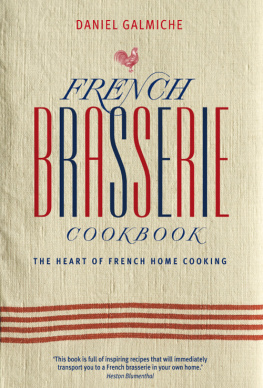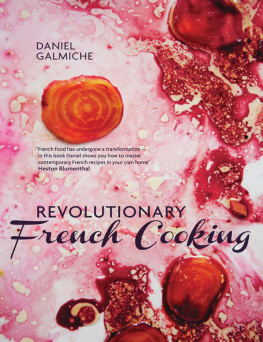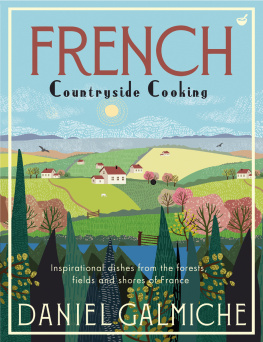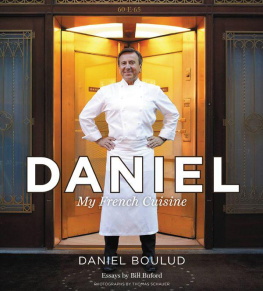DANIEL GALMICHE

FRENCH
BRASSERIE
COOKBOOK
THE HEART OF FRENCH HOME COOKING


Daniel Galmiche
First published in the United Kingdom and Ireland in 2011 by
Duncan Baird Publishers Ltd
Sixth Floor, Castle House
7576 Wells Street
London W1T 3QH
Conceived, created and designed by Duncan Baird Publishers
Copyright Duncan Baird Publishers 2011
Text copyright Daniel Galmiche 2011
Photography copyright Duncan Baird Publishers 2011
The right of Daniel Galmiche to be identified as the Author of this text has been asserted in accordance with the Copyright, Designs and Patents Act of 1988.
All rights reserved. No part of this book may be reproduced in any form or by any electronic or mechanical means, including information storage and retrieval systems, without permission in writing from the publisher, except by a reviewer who may quote brief passages in a review.
Managing Editor: Grace Cheetham
Editors: Camilla Davis and Nicole Bator
French Consultant: Sverine Jeauneau
Managing Designer: Manisha Patel
Production: Uzma Taj
Commissioned Photography: Yuki Sugiura
Photography assistant: Mick English
Food Stylists: Daniel Galmiche with Aya Nishimura
Prop Stylist: Wei Tang
British Library Cataloguing-in-Publication Data: A CIP record for this book is available from the British Library
ISBN: 978-1-84483-992-6
10 9 8 7 6 5 4 3 2 1
Typeset in ITC new Baskerville and MetaPlus Colour reproduction by Colourscan, Singapore Printed in China by Imago
PUBLISHERS NOTE
While every care has been taken in compiling the recipes for this book, Duncan Baird Publishers, or any other persons who have been involved in working on this publication, cannot accept responsibility for any errors or omissions, inadvertent or not, that may be found in the recipes or text, nor for any problems that may arise as a result of preparing one of these recipes. If you are pregnant or breastfeeding or have any special dietary requirements or medical conditions, it is advisable to consult a medical professional before following any of the recipes contained in this book. Some wild mushrooms can be fatally poisonous, however you cook them. Neither the publisher nor the author can take any responsibility for any illness or other unintended consequences resulting from following any of the advice or suggestions in this book.
NOTES ON THE RECIPES
Unless otherwise stated:
All recipes serve 4
Use medium eggs, fruit and vegetables
Use fresh ingredients, including herbs and chillies
Do not mix metric and imperial measurements
1 tsp = 5ml 1 tbsp = 15ml 1 cup = 250ml
Dedication
To three very special people: to my mum, Anne-Marie, and my late Great-Aunt Suzanne for their love and passion for cooking, which they passed on to me; and to my first teacher, the late Yves Lalloz, who took me on when I was 15 and guided me wisely through my three-year apprenticeship with him; and finally to my wife, Claire, for her charm, friendship and unconditional support, and my son Antoine, whose love of life and food is contagious. My profound thanks to you all.

FOREWORD
Ever since my first wonderful meal at Harveys in Bristol many years ago, I have been a great fan of Daniels cooking. He is a true master of contemporary French cuisine and his passion, expertise and attention to detail have ensured that dining at his table is never a disappointment. Who better, then, to teach the classics of the French kitchen?
The French Brasserie Cookbook contains all the recipes that you would expect, from Cheese Souffl to Duck Rillettes, from Bouillabaisse to the perfect tarte tatin, but many of the classics have been given Daniels unique twists. Alongside traditional onion soup, cassoulet and Beef Bourguignon are Lime Risotto, Moules Marinires with Lemongrass & Chilli, and Coffee Crme Caramel. Its a fantastic combination of recipes and flavours.
And despite Daniels huge talent as a Michelinstarred chef, this book is extremely accessible. It is practical, unfussy and easy to use but, most satisfyingly, it is full of inspiring recipes that will immediately transport you to a French brasserie in your own home.
Heston Blumenthal
Contents
Les Bases
Les Entres
Les Viandes
Les Poissons et Les Fruits de Mer
Les Plats Vgtariens
Les Accompagnements et Salades
Les Desserts
INTRODUCTION
What is it about brasseries?
Im sitting on my balcony at home, musing on food as usual and asking myself what it is about brasseries that we all love so much. So Im thinking ... you can take a trip to Paris for a weekend and find yourself wandering happily through the wide boulevards, cobbled side streets and paved courtyards. You spot a stylish yet unassuming terrace and think you might sit outside and watch the world go by for an hour or so but something draws you in. Is it the warm ambience and friendly faces? Is it the dark polished wood of the bar and ornate handles of the bar dispenser ready to serve you beer on tap? Is it the shining brass, the comfortable banquettes or the stunning art deco mirrors? Or is it quite simply the fantastic and mouth-watering smell of food drifting out of the kitchen? Whatever it is, its irresistible.
As soon as you enter a brasserie in France, you are struck by a feeling of timelessness. Youre ushered to a table by a garon de caf with a long, white apron, black bow tie and a quirky sense of humour. He seems to glide effortlessly amid the hustle and bustle of the busy interior and settles you into a cosy corner made more intimate by the stained-glass partition that boasts an elaborate hand-painted scene in the style of Toulouse Lautrec or a simple fleur de lys. You gaze around at the tarnished candlesticks and glamorous chandeliers and yet there is nothing grand or intimidating about being here theres too much laughter and conviviality in the air for that. And it occurs to you that brasseries are something of a paradox: sophisticated yet informal, chic yet unpretentious, boisterous yet elegant.
Popular for more than a century, brasseries are the fabled haunt of artists and writers, the meeting place of politicians and prime ministers, an attraction where both tourists and locals alike linger to see and be seen. But its not for the fashion or the frivolity that they gather here its for the food.
So how did it all start?
The word brasserie actually means brewery in French. In 1864, Frdric Bofinger, a brewer from Alsace in northeastern France (the region that borders my own, Franche-Comt), made his way to Paris and opened a tiny bar in the heart of the Marais and Faubourg Saint-Antoine area. It served little more than draft beer and sauerkraut. At that time, numerous people were moving to Paris from war-torn Alsace in search of work, so there was a ready market. Beer on tap was unheard of in Paris back then and the quality of the sauerkraut was second to none. The combination took the city by storm and in no time brasseries were springing up all over Paris. The rest of France soon followed, and I think, for this reason, Bofinger could rightly claim to be the father of the Parisian brasserie. What started as a smoky bar filled with Alsatian refugees grew into a magnificent dining room with polished wood, gleaming brass and a stained-glass dome.













